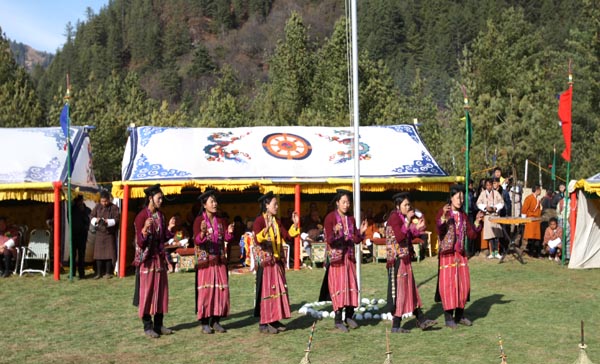
1. Laya-Gasa
Laya is a small district under Gasa Dzongkhag in the Northwestern part of Bhutan. It is inhabited by the indigenous Layap people. It is the highest settlement in the country. The natural splendor of Laya is unparalleled in the country. Livestock is a mainstay, particularly the rearing of yaks. In summer they live in the mountains and migrate to warmer valleys a lower elevation to barter their produce of yak dairy and meats as the cold winter begins to set in. Women of this region have facial features that are distinct from those of other women in Bhutan, and their great love for turquoise jewelry, colorful clothing , and their conical bamboo hats immediately set them apart in any crowd.Like other parts of country , weaving is the household enterprise and the women use looms known as Zum to weave spun yak hair and wool into clothing that protect them from rain and harsh weather.
Things-To-Do :
How To Get there:
Take a drive from Thimphu to Gasa, approx. 6 hours’ drive , hold a night at Gasa.
Early morning leave for Koina , you can either choose to trek for 4-5 hours to reach Koina . The trek is considered as one of the most scenic treks in Bhutan, offering amazing views of some of the most pristine and unspoiled landscapes in Bhutan. Overnight at Camp
Or you can choose to take a dirt road & drive till Koina. Since the road is rugged, it takes 3-4 hours drive and not recommended in summer. Overnight at Camp.
Next Day After breakfast, start trekking to your destination, the beautiful highland village of Laya. The trail winds up gradually and at times with steep climbs till you reach Laya. Early arrival to your camp and enjoy the scenic beauty of the landscape and then you will come across a lot of locals in their typical Laya costumes. Overnight at Camp

2. Merak-Sakteng-Village
Regional Background :
Situated at an altitude over 3,500 meters, the exotic valleys of Merak and Sakten have been home to the Brokpas for centuries since their displacement from Tsona in Southern Tibet. The nomadic indigenous group of eastern Bhutan, the Brokpas seasonally move their herds of livestock from the lower valleys in the winter to the higher pastures in the summer. While polygamy is a prevailing practice as well, marriage among. Like the rest of Bhutan, they are fond of archery and are skilled in games of accuracy. Women are particularly well-known for their singing and they love to perform from their wide repertoire of festive songs dedicated to gods and goddesses, as well as the universal themes of nature, youth and old age. Brokpas prefer to wear their traditional attire spun from yak hair. Traditional wear for men comprise a black hat with five long fringes hanging from the sides. Women usually wear their long hair tied up in plaits with colorful ribbons. An apron reaching to their knees is tied at the waist. Fond of jewelry, they wear long strands of corals, cat’s eyes and necklaces of semi precious stones.
Things to See & Do :
The diverse rituals and customs of the Brokpa people make Merak and Sakten an interesting place to visit, especially each autumn when they honour their mountain goddess Jomo Kuengkhar by observing a two-day festival to seek her blessings for prosperity. The festival is also an occasion to witness the annual naked terchaam dances of the Brokpas and the cultural splendor of the Ache Lhamo dances performed by herders.
There are also several interesting temples and monasteries in both valleys:
The Sakteng Wildlife Sanctuary is another interesting place to explore. It is the only reserve in the world dedicated to protecting the habitat of the yeti or abominable snowman. The sanctuary is mountainous and rugged and boasts a diverse variety of flora and fauna .The park also has rare blue poppies,Bhutan National flower. Premilus and gentiania. that explode in a riot of colors in the spring.
Getting-There:
On landing at Paro, drive to Thimphu, the capital. The next day, I transferred to Bumthang and from there to Trashigang, the furthest eastern region of Bhutan. Overnight in Trashigang, and the following morning take the road further east to Radhi village which is about 21 Km and takes about an hour. After Radhi there is a dirt road that leads to Merak Village. It is about 40 Km and takes about 3 hrs to reach there.
Sakteng is better approached from Merak. From Merak a full day’s trek brings you to the riverside campground at Miksa Teng. Next day take a gradual three hour walk through some pleasant woods until your arrival in Sakteng.
